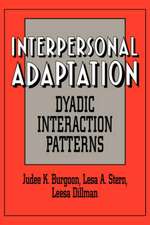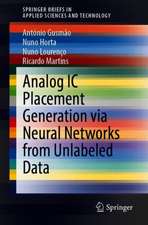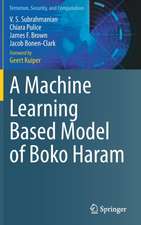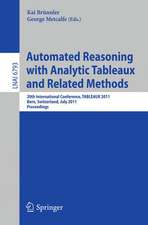Detecting Trust and Deception in Group Interaction: Terrorism, Security, and Computation
Editat de V. S. Subrahmanian, Judee K. Burgoon, Norah E. Dunbaren Limba Engleză Hardback – 8 feb 2021
Meetings are at the very heart of human activity. Whether you are involved in a business meeting or in a diplomatic negotiation, such an event has multiple actors, some cooperative and some adversarial. Some actors may be deceptive, others may have complex relationships with others in the group. This book consists of a set of 11 chapters that describe the factors that link human behavior in group settings and attitudes to facial and voice characteristics.
Researchers working in social sciences (communication, psychology, cognitive science) with an interest in studying the link between human interpersonal behavior and facial/speech/linguistic characteristics will be interested in this book. Computer scientists, who are interested in developing machine learning and deep learning based models of human behavior in group settings will also be interested in purchasing this book.
| Toate formatele și edițiile | Preț | Express |
|---|---|---|
| Paperback (1) | 642.33 lei 6-8 săpt. | |
| Springer International Publishing – 8 feb 2022 | 642.33 lei 6-8 săpt. | |
| Hardback (1) | 648.59 lei 6-8 săpt. | |
| Springer International Publishing – 8 feb 2021 | 648.59 lei 6-8 săpt. |
Preț: 648.59 lei
Preț vechi: 810.74 lei
-20% Nou
Puncte Express: 973
Preț estimativ în valută:
124.10€ • 129.93$ • 102.69£
124.10€ • 129.93$ • 102.69£
Carte tipărită la comandă
Livrare economică 05-19 aprilie
Preluare comenzi: 021 569.72.76
Specificații
ISBN-13: 9783030543822
ISBN-10: 303054382X
Ilustrații: X, 222 p. 47 illus., 42 illus. in color.
Dimensiuni: 155 x 235 mm
Greutate: 0.5 kg
Ediția:1st ed. 2021
Editura: Springer International Publishing
Colecția Springer
Seria Terrorism, Security, and Computation
Locul publicării:Cham, Switzerland
ISBN-10: 303054382X
Ilustrații: X, 222 p. 47 illus., 42 illus. in color.
Dimensiuni: 155 x 235 mm
Greutate: 0.5 kg
Ediția:1st ed. 2021
Editura: Springer International Publishing
Colecția Springer
Seria Terrorism, Security, and Computation
Locul publicării:Cham, Switzerland
Cuprins
Part I: Theory Underlying Investigating Deception in Groups.- 1. Prelude: Relational Communication and the link to Deception.- 2 An integrated Spiral Model of Trust.- 3. The Impact of Culture in Deception and Deception Detection.- Part II: The SCAN Project.- 4. A System for Multi-Person, Multi-Modal Data Collection in Behavioral Information Systems.- 5. Dominance in Groups: How Dyadic Power Theory Can Apply to Group Discussions.- 6. Behavioral Indicators of Dominance in an Adversarial Group Negotiation Game.- 7. Attention-based Facial Behavior Analytics in Social Communication.- 8. Iterative Collective Classification for Visual Focus of Attention Prediction.- Part III: SCAN Project Foundations: Preceding Empirical Investigations of Deception.- 9. Effects of Modality Interactivity and Deception Communication Quality and Task Performance.- 10. Incremental Information Disclosure in Qualitative Financial Reporting: Differences between Fraudulent and Non-Fraudulent Companies.- 11. Cultural Influence on Deceptive Communication.-
Notă biografică
V.S. Subrahmanian is the Dartmouth College Distinguished Professor in Cybersecurity, Technology, and Society and Director of the Institute for Security, Technology, and Society at Dartmouth. He previously served as a Professor of Computer Science at the University of Maryland from 1989-2017 where he created and headed both the Lab for Computational Cultural Dynamics and the Center for Digital International Government. He also served for 6+ years as Director of the University of Maryland's Institute for Advanced Computer Studies. Prof. Subrahmanian is an expert on big data analytics including methods to analyze text/geospatial/relational/social network data, learn behavioral models from the data, forecast actions, and influence behaviors with applications to cybersecurity and counterterrorism. He has written five books, edited ten, and published over 300 refereed articles. He is a Fellow of the American Association for the Advancement of Science and the Association for theAdvancement of Artificial Intelligence and received numerous other honors and awards. His work has been featured in numerous outlets such as the Baltimore Sun, the Economist, Science, Nature, the Washington Post, American Public Media. He serves on the editorial boards of numerous journals including Science, the Board of Directors of the Development Gateway Foundation (set up by the World Bank), SentiMetrix, Inc., and on the Research Advisory Board of Tata Consultancy Services. He previously served on DARPA's Executive Advisory Council on Advanced Logistics and as an ad-hoc member of the US Air Force Science Advisory Board.Judee K. Burgoon is Director of Research for the Center for the Management of Information at the University of Arizona, where she holds titles as professor of communication, family studies and human development. She has authored or edited 17 books and monographs (Detecting Trust and Deception in Group Interaction, Social Signal Processing, Discovering Hidden Temporal Patterns in Behavior and Interaction, Nonverbal Communication, Interpersonal Adaptation, Small Group Communication, Mexican Americans and the Mass Media) and over 300 articles, chapters and reviews. Her current research on deception, dyadic interaction, and technologies for automated analysis of nonverbal and verbal communication has been funded by the National Science Foundation; Department of Defense Air Force, Army, Navy and ODNI; Department of Homeland Security; IARPA; and Gannett Foundation, among others. She is the recipient of the highest honors given by the International Communication Association and National Communication Association and has held several offices in NCA including Chair of the Nonverbal Communication Division and Chair of the Research Board. She also served as Site Director of the Center for Identification Research, an NSF multi-university research organization.
Norah E. Dunbar is a Professor of Communication at the Universityof California Santa Barbara. She teaches courses in nonverbal and interpersonal communication, communication theory, and deception detection. She is also an Affiliate Faculty in the Center for Information, Technology & Society; the Center for Digital Games Research; the Center for Responsible Machine Learning, and the Quantitative Methods in the Social Sciences program. She has received over $13 Million in research funding from agencies such as the Intelligence Advanced Research Projects Activity, the National Science Foundation, the Department of Defense, and the Center for Identification Technology Research. She has published over 65 peer-reviewed journal articles and book chapters and has presented over 100 papers at National and International conferences. Her research has appeared in top journals in her discipline including Communication Research, Communication Monographs, and Journal of Computer-Mediated Communication as well as interdisciplinary journals such as Journal of Management Information Systems and Computers in Human Behavior. She has served on the editorial board of over a dozen disciplinary journals and as the Chair of the Nonverbal Division of the National Communication Association in 2014-2016. She is the current Chair of the Communication Department at UCSB.
Norah E. Dunbar is a Professor of Communication at the Universityof California Santa Barbara. She teaches courses in nonverbal and interpersonal communication, communication theory, and deception detection. She is also an Affiliate Faculty in the Center for Information, Technology & Society; the Center for Digital Games Research; the Center for Responsible Machine Learning, and the Quantitative Methods in the Social Sciences program. She has received over $13 Million in research funding from agencies such as the Intelligence Advanced Research Projects Activity, the National Science Foundation, the Department of Defense, and the Center for Identification Technology Research. She has published over 65 peer-reviewed journal articles and book chapters and has presented over 100 papers at National and International conferences. Her research has appeared in top journals in her discipline including Communication Research, Communication Monographs, and Journal of Computer-Mediated Communication as well as interdisciplinary journals such as Journal of Management Information Systems and Computers in Human Behavior. She has served on the editorial board of over a dozen disciplinary journals and as the Chair of the Nonverbal Division of the National Communication Association in 2014-2016. She is the current Chair of the Communication Department at UCSB.
Textul de pe ultima copertă
This book analyzes the multimodal verbal and nonverbal behavior of humans in both an artificial game, based on the well-known Mafia and Resistance games, as well as selected other settings. This book develops statistical results linking different types of facial expressions (e.g. smile, pursed lips, raised eyebrows), vocal features (e.g., pitch, loudness) and linguistic features (e.g., dominant language, turn length) with both unary behaviors (e.g. is person X lying?) to binary behaviors (Is person X dominant compared to person Y? Does X trust Y? Does X like Y?). In addition, this book describes machine learning and computer vision-based algorithms that can be used to predict deception, as well as the visual focus of attention of people during discussions that can be linked to many binary behaviors. It is written by a multidisciplinary team of both social scientists and computer scientists.
Meetings are at the very heart of human activity. Whether you are involved in a business meeting or in a diplomatic negotiation, such an event has multiple actors, some cooperative and some adversarial. Some actors may be deceptive, others may have complex relationships with others in the group. This book consists of a set of 11 chapters that describe the factors that link human behavior in group settings and attitudes to facial and voice characteristics.
Researchers working in social sciences (communication, psychology, cognitive science) with an interest in studying the link between human interpersonal behavior and facial/speech/linguistic characteristics will be interested in this book. Computer scientists, who are interested in developing machine learning and deep learning based models of human behavior in group settings will also be interested in purchasing this book.
Meetings are at the very heart of human activity. Whether you are involved in a business meeting or in a diplomatic negotiation, such an event has multiple actors, some cooperative and some adversarial. Some actors may be deceptive, others may have complex relationships with others in the group. This book consists of a set of 11 chapters that describe the factors that link human behavior in group settings and attitudes to facial and voice characteristics.
Researchers working in social sciences (communication, psychology, cognitive science) with an interest in studying the link between human interpersonal behavior and facial/speech/linguistic characteristics will be interested in this book. Computer scientists, who are interested in developing machine learning and deep learning based models of human behavior in group settings will also be interested in purchasing this book.
Caracteristici
One of the first books to study the link between human behavior in group settings with facial expressions and speech analysis One of the first books to illustrate how advanced machine learning and deep learning techniques can be used to predict deceptive behavior Combines social science models and computational models for better understanding of deception, like/dislike, dominance/deference, and other interpersonal behaviors Analyzes the impact of culture on interpersonal deception Includes one of the most in-depth, multimodal analyses of relational communication in groups



































